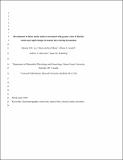| dc.contributor.author | Lee, S. S. M. | |
| dc.contributor.author | de Boef Miara, M. | |
| dc.contributor.author | Arnold, A. S. | |
| dc.contributor.author | Biewener, Andrew Austin | |
| dc.contributor.author | Wakeling, J. M. | |
| dc.date.accessioned | 2014-07-25T13:46:15Z | |
| dc.date.issued | 2013 | |
| dc.identifier.citation | Lee, S. S. M., M. de Boef Miara, A. S. Arnold, A. A. Biewener, and J. M. Wakeling. 2013. “Recruitment of Faster Motor Units Is Associated with Greater Rates of Fascicle Strain and Rapid Changes in Muscle Force During Locomotion.” Journal of Experimental Biology 216, no. 2: 198–207. | en_US |
| dc.identifier.issn | 0022-0949 | en_US |
| dc.identifier.uri | http://nrs.harvard.edu/urn-3:HUL.InstRepos:12560996 | |
| dc.description.abstract | Animals modulate the power output needed for different locomotor tasks through changes in muscle force production and fascicle strain rate. To generate sufficient force, appropriate motor unit recruitment must occur. Given that faster motor units contract with faster strain rates and have faster activation-deactivation rates, it is therefore likely that faster motor units are recruited for more rapid movements. The goals of this study were to 1) describe changes in motor unit recruitment patterns that occur with changes in locomotor dynamics and 2) test whether motor unit recruitment can be directly related to in vivo measures of muscle force and fascicle strain and strain rate, and thus mechanical work. Myoelectric, sonomicrometric, and muscle-tendon force data were collected from the lateral and medial gastrocnemius muscles of the goat hind limb during level and incline walking and trotting, and level galloping. Myoelectric signals were analyzed using wavelet and principal component analysis in order to quantify changes to the myoelectric frequency spectra across locomotor conditions. Fascicle strain and strain rate were calculated from the sonomicrometric data, and force rate was calculated from the tendon force data. The results of this study demonstrate that, under certain locomotor conditions such as level galloping and incline walking, where EMG activity were similar but had different frequency components, faster and slower motor units are recruited in patterns that were task-specific. The study also shows that the recruitment patterns of different motor unit types are related to in vivo fascicle strain rates in addition to myoelectric intensity and force. Together, these data provide evidence that changes in motor unit recruitment have an underlying mechanical basis, at least for certain locomotor tasks. | en_US |
| dc.description.sponsorship | Organismic and Evolutionary Biology | en_US |
| dc.language.iso | en_US | en_US |
| dc.publisher | The Company of Biologists | en_US |
| dc.relation.isversionof | doi:10.1242/jeb.072637 | en_US |
| dash.license | OAP | |
| dc.subject | Electromyography, motor unit, muscle force, fascicle strain, activation | en_US |
| dc.title | Recruitment of faster motor units is associated with greater rates of fascicle strain and rapid changes in muscle force during locomotion | en_US |
| dc.type | Journal Article | en_US |
| dc.description.version | Accepted Manuscript | en_US |
| dc.relation.journal | Journal of Experimental Biology | en_US |
| dash.depositing.author | Biewener, Andrew Austin | |
| dc.date.available | 2014-07-25T13:46:15Z | |
| dc.identifier.doi | 10.1242/jeb.072637 | * |
| dash.contributor.affiliated | Biewener, Andrew | |


